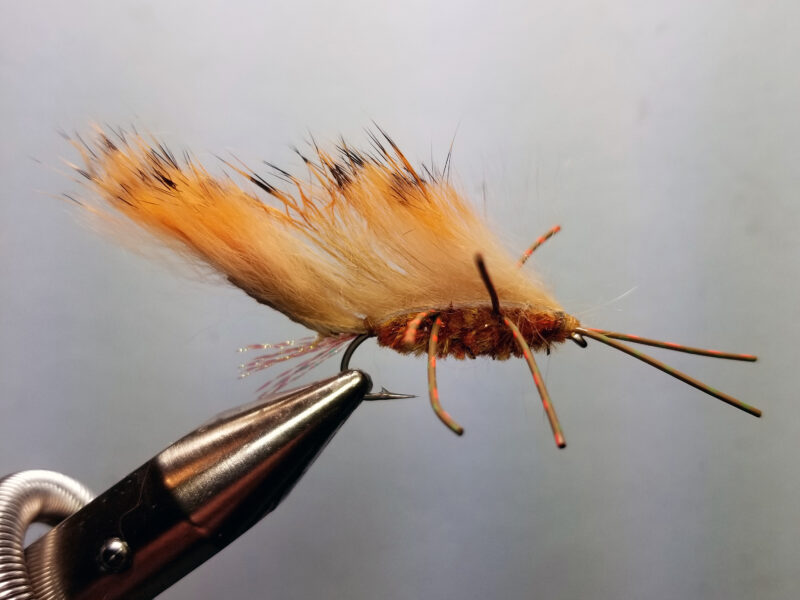Willy’s Pip (Easy Midge Pupa) Fly Tying Video
Posted on March 4th, 2021
Intro to the Willy’s Pip, an Easy Midge Pupa
This simple midge is one of my (Walter’s) favorite flies when I go back to fish the Ozarks tailwaters and spring creeks between November and April. The extended furled body creates a profile similar to the classic Brassie, but with a great deal of movement and a different “look.” The first two-foot trout I ever caught came on one of these, on upper Lake Taneycomo in Missouri (it’s really a river there).
In addition to working well as an easy midge pupa, the technique used to create the abdomen is also good for caddis pupae, extended body stonefly dries like my Prom Queen, and even leech tails. Any relatively straight, limp fiber, yarn, or braid can work with this technique.
Recipe
Hook: Scud, #18-22
Bead: Tiny brass or tungsten, if desired. I usually do not include one.
Thread: 8/0 or smaller black or to match abdomen.
Abdomen: Red Uni-Thread, furled. Other good colors include cream, olive, tan, black, or one of the various flashy “midge threads.”
Thorax/Head: Peacock herl or Ice Dub.
Scleech Streamer Fly Tying Video
Posted on March 4th, 2021
Scleech Streamer Introduction
The Scleech is my favorite double-hook streamer. The title is a bit of a lie. It’s not actually a true articulated pattern, rather a single-hook streamer with a stinger hook and the fly’s body on the connection between the main hook and the stinger. If I wasn’t yacking, I can tie these in about ten minutes, much less than most similar-sized streamers.
This is a great fly in early spring (late March through early June) on the Yellowstone, but it can work all summer and fall too. Usually I fish the fly on a seven-weight rod, with a type-IV sink tip line and about 10lb Maxima for tippet. Strip and rip, but don’t hesitate to high-stick nymph it through the turbulent, foamie, bankside pockets, particularly in midsummer when the big browns sit in those spots and don’t like it when other fish invade their territory.
The fly is also good in all standard sculpin colors: gold, tan, black, and “Bighorn,” or yellow and dark brown. I also tie it in white, though why it works in that color, I have no idea.
While primarily a sculpin imitation these days, I also use the fly as a big leech in small private ranch lakes, especially in early April right after ice-out, when the big fish are lethargic and often prefer one big meal to a lot of smaller ones. In those situations, fish it on a slower-sinking line with long, slow strips.
Tying Recipe
Front Hook: Clouser-style, #2-4 (here, an old Mustad #3366 in size-4).
Thread: 3/0 olive (or to match fly’s overall color).
Wing: Black-barred olive variant rabbit strip, or standard olive variant rabbit strip.
Rear Hook: #6 scud or similar short-shank wide-gape hook (egg, octopus, etc.).
Articulation/Body: 40lb Power Pro braided fishing line strung with eight 6mm golden olive acrylic craft store beads.
Eyes: Medium gold I-Balz.
Body #2: Other end of rabbit strip used for wing, secured and wrapped forward as in a bunny leech, 3-4 turns.
Throat: Red flash, here an odd formulation of red Kreinik Flash, but any material will work.
Collar/Dorsal Fin: Olive Montana Fly Company Widow’s Web.
Head: Olive Widow’s Web, spun in a dubbing loop, wrapped forward, and trimmed to shape.
Markings: Color top side of head and all of collar/dorsal fin with a brown permanent marker, then bar with a black permanent marker.
Zirdle Bug Fly Tying Video
Posted on March 4th, 2021
Zirdle Bug Intro
The Zirdle Bug is a red-hot streamer/nymph combo “junk fly” in southwest Montana, particularly on lower-elevation rivers like the Beaverhead, Lower Madison, Jefferson, and Missouri, where crayfish are present.
The secret to the Zirdle Bug’s success is that it looks like a wide range of food items and can be fished in a variety of ways. It roughly matches crayfish, sculpins and other baitfish, as well as stonefly nymphs. I have caught fish on this pattern in the following ways: swung or stripped like a streamer, dead-drifted under an indicator, dragged on a tight line under an indicator, and even in small sizes under large hopper or Chubby Chernobyl patterns. Probably the most popular method to fish the Zirdle is under an indicator.
This one is sort of a tan-copper-brown-orange color, but you can tie them in a wide range of natural and attractor colors. This one is merely intended to serve as an example.
The Zirdle Bug was originally produced by Solitude Fly Company, but is now tied by most wholesale fly companies.
Hook: #4-12 3xl nymph/streamer, here #6.
Weight: .015-.035 lead or lead-free wire, here .035.
Thread: 6/0 to match or contrast the body, here light brown.
Tail: Krystal Flash. Here, root beer.
Body: Brindle chenille, here Amberstone New Age Chenille.
Legs: Medium round rubber, here Wapsi barred rubber in olive with chartreuse and orange specks.
Wing: Standard rabbit strip, here black-barred tan with orange tips.
